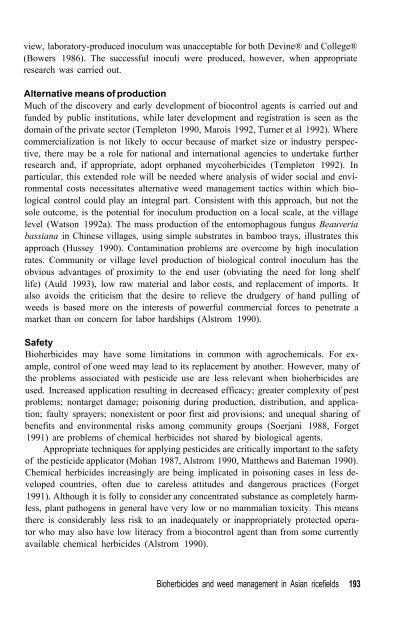HERBICIDES in Asian rice - IRRI books - International Rice ...
HERBICIDES in Asian rice - IRRI books - International Rice ...
HERBICIDES in Asian rice - IRRI books - International Rice ...
Create successful ePaper yourself
Turn your PDF publications into a flip-book with our unique Google optimized e-Paper software.
view, laboratory-produced <strong>in</strong>oculum was unacceptable for both Dev<strong>in</strong>e® and College®<br />
(Bowers 1986). The successful <strong>in</strong>oculi were produced, however, when appropriate<br />
research was carried out.<br />
Alternative means of production<br />
Much of the discovery and early development of biocontrol agents is carried out and<br />
funded by public <strong>in</strong>stitutions, while later development and registration is seen as the<br />
doma<strong>in</strong> of the private sector (Templeton 1990, Marois 1992, Turner et al 1992). Where<br />
commercialization is not likely to occur because of market size or <strong>in</strong>dustry perspective,<br />
there may be a role for national and <strong>in</strong>ternational agencies to undertake further<br />
research and, if appropriate, adopt orphaned mycoherbicides (Templeton 1992). In<br />
particular, this extended role will be needed where analysis of wider social and environmental<br />
costs necessitates alternative weed management tactics with<strong>in</strong> which biological<br />
control could play an <strong>in</strong>tegral part. Consistent with this approach, but not the<br />
sole outcome, is the potential for <strong>in</strong>oculum production on a local scale, at the village<br />
level (Watson 1992a). The mass production of the entomophagous fungus Beauveria<br />
bassiana <strong>in</strong> Ch<strong>in</strong>ese villages, us<strong>in</strong>g simple substrates <strong>in</strong> bamboo trays, illustrates this<br />
approach (Hussey 1990). Contam<strong>in</strong>ation problems are overcome by high <strong>in</strong>oculation<br />
rates. Community or village level production of biological control <strong>in</strong>oculum has the<br />
obvious advantages of proximity to the end user (obviat<strong>in</strong>g the need for long shelf<br />
life) (Auld 1993), low raw material and labor costs, and replacement of imports. It<br />
also avoids the criticism that the desire to relieve the drudgery of hand pull<strong>in</strong>g of<br />
weeds is based more on the <strong>in</strong>terests of powerful commercial forces to penetrate a<br />
market than on concern for labor hardships (Alstrom 1990).<br />
Safety<br />
Bioherbicides may have some limitations <strong>in</strong> common with agrochemicals. For example,<br />
control of one weed may lead to its replacement by another. However, many of<br />
the problems associated with pesticide use are less relevant when bioherbicides are<br />
used. Increased application result<strong>in</strong>g <strong>in</strong> decreased efficacy; greater complexity of pest<br />
problems; nontarget damage; poison<strong>in</strong>g dur<strong>in</strong>g production, distribution, and application;<br />
faulty sprayers; nonexistent or poor first aid provisions; and unequal shar<strong>in</strong>g of<br />
benefits and environmental risks among community groups (Soerjani 1988, Forget<br />
1991) are problems of chemical herbicides not shared by biological agents.<br />
Appropriate techniques for apply<strong>in</strong>g pesticides are critically important to the safety<br />
of the pesticide applicator (Mohan 1987, Alstrom 1990, Matthews and Bateman 1990).<br />
Chemical herbicides <strong>in</strong>creas<strong>in</strong>gly are be<strong>in</strong>g implicated <strong>in</strong> poison<strong>in</strong>g cases <strong>in</strong> less developed<br />
countries, often due to careless attitudes and dangerous practices (Forget<br />
1991). Although it is folly to consider any concentrated substance as completely harmless,<br />
plant pathogens <strong>in</strong> general have very low or no mammalian toxicity. This means<br />
there is considerably less risk to an <strong>in</strong>adequately or <strong>in</strong>appropriately protected operator<br />
who may also have low literacy from a biocontrol agent than from some currently<br />
available chemical herbicides (Alstrom 1990).<br />
Bioherbicides and weed management <strong>in</strong> <strong>Asian</strong> <strong>rice</strong>fields 193

















